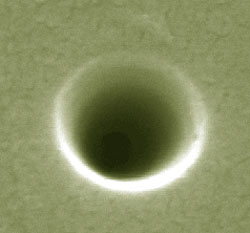The Simplest Pump

Researchers have created a nanoscale ion pump by punching a tiny hole in a plastic sheet and applying an oscillating electric field. Their modeling indicates that the single conical pore works like a ratchet, according to the 4 November print issue of PRL. The group hopes that the device will eventually help explain ion pumps and channels in biological cells, the inspirations for their work.
Micron-sized beads have already been pushed “uphill,” against electrochemical forces, through specially shaped small holes. Zuzanna Siwy of the Institute for Heavy Ion Research (GSI) in Darmstadt, Germany, and Andrzej Fulinski of Jagellonian University in Krakow wanted to take the next step and pump single ions through nanosized pores. To produce such holes, they shot high-energy gold atoms from GSI’s UNILAC machine into thin plastic foils. Using a very low intensity beam, they could gouge essentially isolated tracks in the material. Chemical etching then expanded each tunnel in the plastic into a cone that went from 2 nanometers wide on one side to 500 nanometers on the other.
The researchers placed the film in a solution of potassium chloride and measured its current-voltage characteristics as they applied an AC voltage across the sheet. And as they had hoped, the pores pumped potassium ions to one side, increasing their concentration there at the expense of the other side. Surprisingly, “the concentration gradient [opposing pumping] had to be 10-fold or larger to make the pumping stop,” says Siwy, who adds that this is the first simple “diode” for ions.
They calculated that the electric potential inside the pore was asymmetric, shaped like a ratchet’s tooth. Applying an oscillating voltage “rocked” the potential, so ions could pass through. The ions more often went from the narrower end of the cone to the wider one because the attractive force was more concentrated at the narrow end. The pair would like to try separating different types of ions with the pump and are working on crafting smaller pores from thinner sheets.
At smaller sizes, the pores won’t be much bigger than the large molecules that control the flow of ions into and out of cells. Biological potassium ion pumps are asymmetric in shape–as are the synthetic pores–and Siwy hopes their device will reveal something about that or other living systems. But “we cannot say they are biological–the biologists would kill us immediately,” she says. In related work, the team recently used similar pores to learn about currents moving through biological channels, which passively allow ions to flow into and out of cells [1].
“This idea of pumping with synthetic nanopores is exciting and should be pursued further,” says Peter Hänggi of the University of Augsburg in Germany. He expects diffusion forces to pump some ions even when the AC voltage is weak. Dean Astumian of the University of Maine anticipates future experiments in which chemical modifications around the pore would control the amplitude and direction of the ionic current. He also says the device could test proposed mechanisms in biological channels. “I find such experiments more convincing than the typical biological approach” because the link between synthetic pores and ion flow can be analyzed more easily.
–JR Minkel
JR Minkel is a freelance science writer in New York City.
References
- Z. Siwy and A. Fulinski, Phys. Rev. Lett. 89, 158101 (2002)
More Information
Response to this paper: Phys. Rev. Lett. 91, 179801 (2003)


